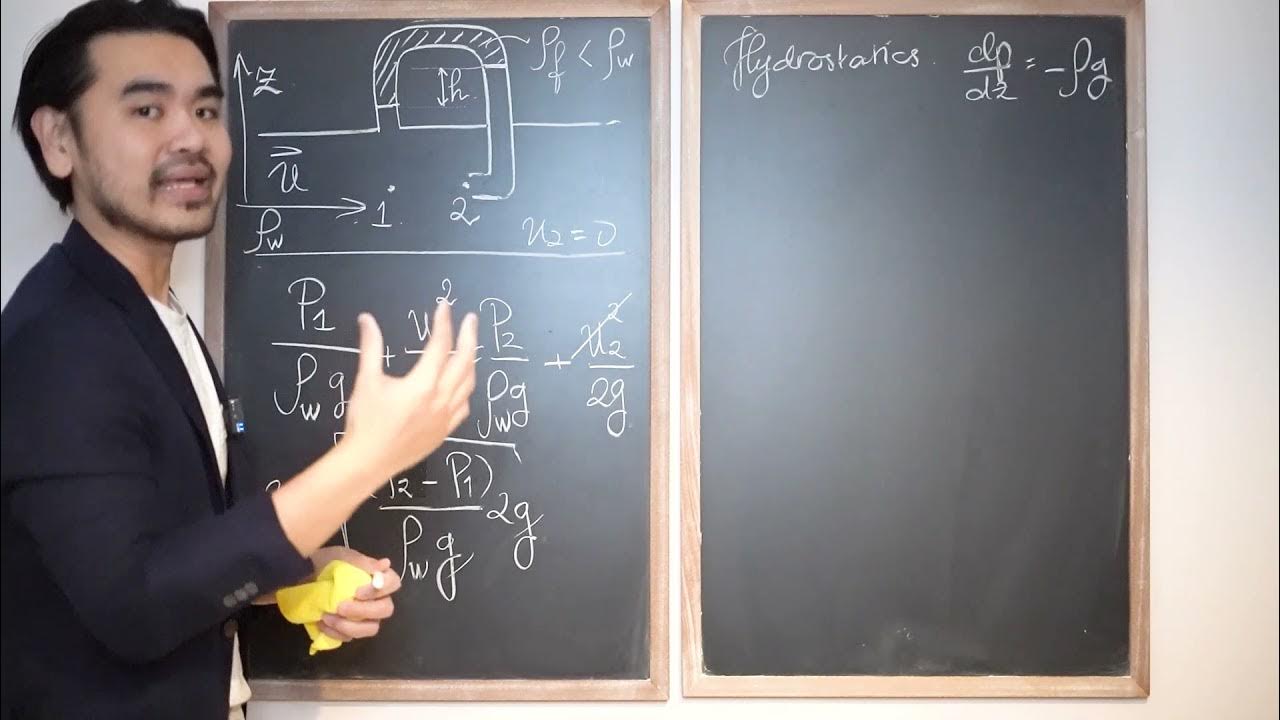Hukum bernoulli pada tangki bocor
Summary
TLDRIn this video, the application of Bernoulli's principle is explored to determine the velocity and trajectory of water exiting a leaking tank. The continuity equation is first applied to find the fluid velocity at different points, with the assumption that the velocity at the top surface of the tank is negligible. Using Bernoulli’s equation, the velocity of water leaving the hole is calculated, and basic projectile motion principles are used to determine the horizontal distance the water travels. The example concludes with the calculation of a 5.47 m/s exit velocity and a horizontal distance of 3.45 meters.
Please replace the link and try again.
Q & A
What is the primary focus of this video script?
-The primary focus of the video is to explain the application of Bernoulli's Law and the Continuity Equation to a leaking tank, specifically calculating the velocity of water exiting the tank and the maximum range of the water jet.
What is Bernoulli's Law, and how is it applied in this scenario?
-Bernoulli's Law states that in a streamline flow of an incompressible fluid, the total mechanical energy (pressure energy, kinetic energy, and gravitational potential energy) remains constant. In this scenario, it is used to calculate the velocity of water exiting a tank by equating the pressures and energies at different points (top and hole) of the fluid flow.
Why is the velocity of the water at the top of the tank considered negligible?
-The velocity at the top of the tank (V1) is considered negligible because the area of the top surface (A1) is much larger than the area of the hole (A2). According to the Continuity Equation, the velocity at the top (V1) is inversely proportional to the area, so with A1 being much larger than A2, V1 becomes effectively zero.
What is the Continuity Equation, and how does it relate to this problem?
-The Continuity Equation, A1V1 = A2V2, represents the conservation of mass in fluid flow. It indicates that the product of the cross-sectional area and velocity is constant along a streamline. In this case, the velocity at the hole (V2) is calculated using the Continuity Equation, with the velocity at the top (V1) approximated as zero.
What is the simplified form of Bernoulli’s equation used in this problem?
-The simplified form of Bernoulli's equation, given that the velocity at the top (V1) is zero and the pressures at both points are equal, is: ρgh = (1/2)ρV2², where ρ is the fluid density, g is the gravitational acceleration, h is the height difference, and V2 is the velocity of water exiting the hole.
How is the velocity of the water exiting the hole calculated?
-The velocity (V2) of water exiting the hole is calculated using the formula V2 = √(2gh), where g is the acceleration due to gravity and h is the effective height (H + H2). This gives the speed at which the water leaves the tank.
What role does projectile motion play in determining the horizontal distance the water travels?
-Once the water exits the hole, it follows a parabolic path governed by projectile motion. The horizontal velocity remains constant, and the vertical motion is influenced by gravity. The time it takes for the water to fall to the ground (t) is determined by its vertical motion, and the horizontal distance is calculated by multiplying the horizontal velocity by the time.
How is the time for the water to fall to the ground calculated?
-The time (t) for the water to fall to the ground is calculated using the formula t = √(2h2/g), where h2 is the height of the hole from the ground, and g is the gravitational acceleration. This gives the duration of the fall before the water hits the ground.
What formula is used to calculate the horizontal distance traveled by the water?
-The horizontal distance (x) traveled by the water is calculated using the formula x = V2 × t, where V2 is the horizontal velocity of the water and t is the time it takes to fall. This gives the maximum range of the water jet.
In the example problem, how was the maximum horizontal distance of the water calculated?
-In the example problem, the velocity of the water exiting the hole was calculated as 5.47 m/s. The time for the water to fall from a height of 2 meters was calculated as 0.63 seconds. The maximum horizontal distance the water traveled was then calculated as 5.47 m/s × 0.63 s = 3.45 meters.
Outlines

This section is available to paid users only. Please upgrade to access this part.
Upgrade NowMindmap

This section is available to paid users only. Please upgrade to access this part.
Upgrade NowKeywords

This section is available to paid users only. Please upgrade to access this part.
Upgrade NowHighlights

This section is available to paid users only. Please upgrade to access this part.
Upgrade NowTranscripts

This section is available to paid users only. Please upgrade to access this part.
Upgrade NowBrowse More Related Video

Penerapan Prinsip Bernoulli Dalam Kehidupan Sehari-Hari

Energi Saluran Terbuka bagian 2

Mekanika Fluida FM01 (Lecture3: 8/8). Energy Line & Hydraulic Grade Line

FISIKA KELAS XI - HUKUM BERNOULLI || FLUIDA DINAMIS

Mekanika Fluida FM01 (Lecture3: 7/8). Static-Pitot Tube

RBL Fisika Dasar 1 - Penerapan Hukum Bernoulli Pada Alat Penyemprot Obat Nyamuk
5.0 / 5 (0 votes)